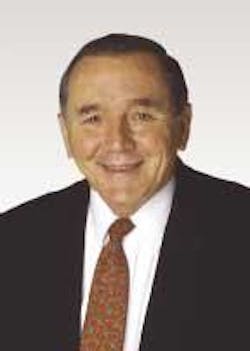Optical technology addresses transportation security challenges
Historically, transportation has been essential to the economy of the nation and the world. Commerce is intimately tied to transportation, with container ships hauling goods across the oceans, airplanes ferrying business people around the country, trucks and trains moving heavy cargo over land, and minivans transporting families between stores. To maintain our standard of living, the flow of transportation must not be encumbered, whether within or across our borders.
In the wake of 9/11, increased concern about the security of our transportation system and our borders poses a risk that mobility and, thereby, our economy could be casualties of increased restrictions on movement. To illustrate the magnitude of the problem, note that approximately 30,000 incoming truck crossings occur each day at our northern and southern borders. With these crossings, nearly $400 billion in trade (exports and imports) occur annually with Canada and Mexico.
Security is not the only challenge facing transportation. Every day, millions of people rely upon our nation’s highways to get to work, go shopping, or take a vacation. But every year, more than 40,000 people die on those highways, with 3 million more left injured.
How do we ensure that our transportation system continues to facilitate commerce, while increasing security and safety and, additionally, minimizing environmental impacts and energy consumption? Advanced technology, especially optics and photonics, can and should play a crucial role in improving and strengthening the transportation system.
A recent report, Riding on Light: Optical Technology for Transportation Challenges, summarized the transportation challenges, potential solutions, and recommendations from a workshop cosponsored by the U.S. Department of Transportation, U.S. Department of Commerce, Optical Society of America, and SPIE-The International Society for Optical Engineering. The workshop had an ambitiously broad scope. Safety, security, mobility, environmental, and energy-efficiency challenges were considered in breakout sessions covering five sectors of the transportation system: air, sea, land (personal and commercial, including rail), and intermodal.
Issues discussed in multiple breakout sessions included security of cargo containers, monitoring engine emissions, increased throughput at terminals, monitoring operators of commercial vehicles for safety and security, and system transformation.
Potential optical solutions
In the intermodal breakout session, for example, technologies were envisioned that might help expedite movement, screen for safety and security, and monitor borders. For verification of cargo “smart seals,” light-sensitive “smart seals” could be inspected at the final destination, or they could be coupled to transmitting devices that would allow electronic random sampling en route or at border crossings. For border monitoring, unmanned aerial vehicles (UAVs) could be used to patrol remote border regions. It was suggested that vehicle inspections at checkpoints could include optical technologies to address tire inspection, brake sensors, emissions control, tire pressure, and headlight alignment. Expediting passengers and cargo at security checkpoints would have economic and security benefits. Optical technologies, including facial, iris, fingerprint, and bio recognition, already exist but standardization and wider implementation are needed.
The optics community should continue to focus on these innovations; however, the U.S. government may want to consider the following recommendations outlined in the report to expedite the developments for the U.S. transportation system:
Leverage federal investments. Foster collaboration among government, industry, and academia to accelerate the deployment of established technologies in the nation’s transportation system.
Invest in research. To be widely deployed, optics and photonics devices and their associated systems need to be affordable, reliable, adaptive, real-time, robust, and unobtrusive.
Set “stretch” goals. The nation needs aggressive “stretch” goals that will challenge the research community to develop new optics and photonic technologies and concepts.
Provide incentives. Government, industry, and academia need incentives, including the infusion of venture and equity capital, performance-based standards, friendly regulatory and certification processes, and innovative financing mechanisms, that will encourage them to create solutions.
Increase education and awareness. Increased awareness of the benefits and applications of optics and photonics technologies is needed in government and industry.
The report suggests a number of optics and photonics technologies that could be applied to the challenges of the transportation sector, but only a few of them could be listed here (see “Other potential solutions to transportation issues”). Details can be found in the full report.1 The report is not the last word, however. In many of these cases, more research and development is necessary to determine if optics and photonics would provide the most effective solutions. Those in government, industry, and academia, in both transportation and optics/photonics, would do well to explore further how the massive challenges facing transportation could be solved using advanced technology.
REFERENCE
1. www.jaop.org.
ACKNOWLEDGMENTS
In addition to the cosponsors of the workshop, I would like to thank Brendan Plapp, who directed the Joint Advocacy for Optics and Photonics (JAOP) and who assisted with this article.
ROBERT P. BREAULTis president and founder of Breault Research Organization, 6400 East Grant Rd., Suite 350, Tucson, AZ 85715; e-mail: [email protected].
Other potential solutions to transportation issues
Synthetic vision: displays substituted for windshields
Situational awareness: real-time, multivariable information about the transportation environment conveyed to operators and controllers
Biometrics: optical scanning of irises, faces, or fingerprints
Chemical/biological/combustion measurement and detection: spectral monitoring of gases, liquids, and aerosols
Infrared sensing: infrared night vision to detect warm-blooded roadway hazards or nighttime intruders
Fiber optics: high-bandwidth communications for intelligent transportation systems (ITS) and drive-by-light; sensors for sound, stress, and nuclear radiation
Lighting and reflectivity: intelligent, efficient lighting, using photocells, solar panels, and light-emitting diodes (LEDs), aided by reflective paints and coatings
Sterilizing: ultraviolet light to kill or render nonviable organisms in ballast water

